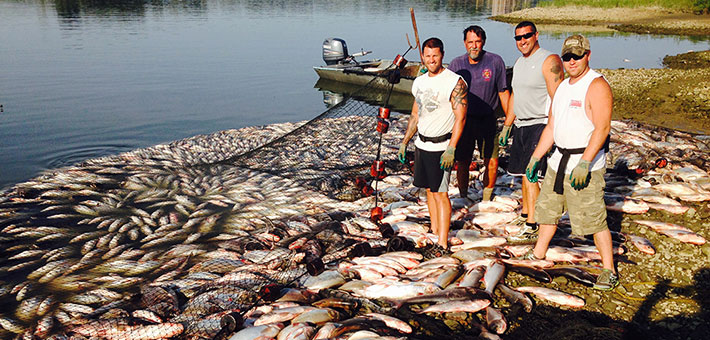Control

Commercial fishermen stand onshore near netted invasive carp. Photo by Michigan Department of Natural Resources
In support of the Invasive Carp Regional Coordinating Committee’s (ICRCC) mission, member agencies are assessing the movement of invasive carp and undertaking strategic control actions focused on removing existing populations.
Targeted Commercial Fishing and Contract Fishing
The use of commercial fishing in invasive carp removal efforts allows ICRCC member agencies to tap into the expertise and resources of local commercial fishing industries.
- Informed by modeling and survey data, commercial fishing enhances the effectiveness of invasive carp removal efforts by targeting the areas most vulnerable to the expansion of invasive carp populations.
- Contracted commercial fishing is used to reduce the numbers of invasive carp in the upper Illinois and lower Des Plaines rivers downstream of the Electric Dispersal Barrier System. By decreasing invasive carp abundance, migration pressure towards the barrier is reduced.
Invasive Carp Population Modeling
Modeling is being used by ICRCC partners to improve our understanding of silver carp and bighead carp population dynamics in the Illinois River. This work can help managers understand the effectiveness of different management strategy scenarios and is used to inform targeted removal efforts.
The ICRCC is continuing to develop a spatially explicit invasive carp population model that will be used to maximize fish harvest effectiveness and reduce numbers of adult invasive carp in the Illinois River and other locations. The model helps managers understand invasive carp population dynamics and allows them to optimize the location and timing of harvest efforts.
New Technologies and Research
ICRCC partners are exploring new technologies and conducting research to improve the effectiveness of control actions. Recent and ongoing work examines:
- The Modified-Unified-Method of invasive carp capture, which uses herding techniques and nets to drive the fish and concentrate them into a smaller area where they can be more easily harvested.
- Traditional fisheries gear and assessments, along with remote sensing technologies, to improve invasive carp harvest.
- The effectiveness of new trap and net technologies and the integration of netting with other technologies.
- The use of split-beam hydroacoustics and side scan sonar to characterize fish populations.
- The use of telemetry to track the movements of invasive carp.
